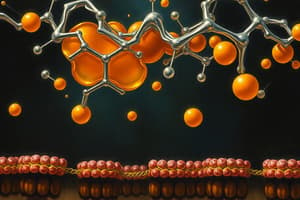Podcast
Questions and Answers
What is the primary function of retinoids in epithelial tissues?
What is the primary function of retinoids in epithelial tissues?
- Inhibit gene expression
- Control gene expression for keratin (correct)
- Facilitate bone development
- Regenerate rhodopsin
What are the components of rhodopsin?
What are the components of rhodopsin?
11-cis retinal and opsin
Vitamin A is not necessary for growth in children.
Vitamin A is not necessary for growth in children.
False (B)
Vitamin A is essential for the differentiation of __________ tissues.
Vitamin A is essential for the differentiation of __________ tissues.
Match the following vitamin A sources with their type:
Match the following vitamin A sources with their type:
Which of the following is NOT a function of vitamin A?
Which of the following is NOT a function of vitamin A?
Retinoic acid is active in maintaining reproduction.
Retinoic acid is active in maintaining reproduction.
Name a source of preformed vitamin A.
Name a source of preformed vitamin A.
Which form of vitamin A is known to be an aldehyde derived from retinol?
Which form of vitamin A is known to be an aldehyde derived from retinol?
Retinoic acid can be converted back into retinal in the body.
Retinoic acid can be converted back into retinal in the body.
What is the primary form of vitamin A found in animal tissues?
What is the primary form of vitamin A found in animal tissues?
Match the following forms of vitamin A with their characteristics:
Match the following forms of vitamin A with their characteristics:
Vitamin A activity of β-carotene is only about one __________ that of retinol.
Vitamin A activity of β-carotene is only about one __________ that of retinol.
What type of protein transports retinol from the liver to extrahepatic tissues?
What type of protein transports retinol from the liver to extrahepatic tissues?
The conversion of retinal to retinol occurs efficiently in the human body.
The conversion of retinal to retinol occurs efficiently in the human body.
What is the role of retinoic acid in target tissues?
What is the role of retinoic acid in target tissues?
Flashcards are hidden until you start studying
Study Notes
Structure of Vitamin A
- Vitamin A includes a group of bioactive molecules termed retinoids, which comprise both natural and synthetic forms.
- Retinol: A primary alcohol with a β-ionone ring and unsaturated side chain, found in animal tissues as retinyl esters.
- Retinal: An aldehyde formed by the oxidation of retinol; retinol and retinal can interconvert easily.
- Retinoic Acid: The acid resulting from the oxidation of retinal; cannot be reduced back to retinal or retinol.
- β-Carotene: Found in plant foods, it can be converted to two molecules of retinal in the intestine, though this process in humans is inefficient.
Absorption and Transport of Vitamin A
- Transport to the Liver: Dietary retinyl esters are hydrolyzed in the intestinal mucosa, releasing retinol and fatty acids, which are then re-esterified and secreted in chylomicrons into the lymphatic system. Chylomicron remnants are taken up by the liver for storage.
- Release from the Liver: Retinol is released and transported to tissues by plasma retinol-binding protein (RBP). The retinol-RBP complex attaches to specific receptors, allowing retinol to enter cells, where it is carried to the nucleus by cellular retinol-binding proteins.
Mechanism of Action of Vitamin A
- Retinol is oxidized to retinoic acid, which binds to specific receptor proteins in the nucleus of target tissues.
- The activated retinoic acid-receptor complex interacts with nuclear chromatin, regulating RNA synthesis and protein production, influencing various physiological functions.
- Retinoids control gene expression, such as keratin in epithelial tissues, and are part of a superfamily of transcriptional regulators, similar to steroid hormones.
Functions of Vitamin A
- Visual Cycle: Vitamin A is crucial for visual pigments in rod and cone cells. Rhodopsin, composed of 11-cis retinal and opsin, undergoes isomerization upon light exposure, regenerating through a series of transformations to maintain vision.
- Growth: A deficiency in vitamin A results in decreased growth rates in children and slowed bone development.
- Reproduction: Retinol and retinal are essential for reproduction; they support spermatogenesis in males and fetal maintenance in females. Retinoic acid is not involved in reproduction or vision but aids growth and epithelial differentiation.
- Maintenance of Epithelial Cells: Necessary for the normal differentiation of epithelial tissues and the secretion of mucus.
Distribution of Vitamin A
- Rich sources include liver, kidney, cream, butter, and egg yolk for pre-formed vitamin A.
- Yellow and dark green vegetables and fruits are dietary sources of carotenes, precursors for vitamin A synthesis.
Studying That Suits You
Use AI to generate personalized quizzes and flashcards to suit your learning preferences.




